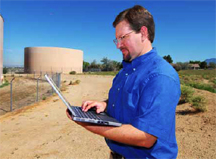
Sandia researchers are working with the US Environmental Protection Agency (EPA), University of Cincinnati, and Argonne National Laboratory to develop contaminant warning systems that can monitor municipal water systems to determine quickly when and where contamination occurs.
It’s all part of the EPA’s Threat Ensemble Vulnerability Assessment (TEVA) program to counter threats against water systems. The program uses a suite of software tools that can simulate threats and identify vulnerabilities in drinking water systems, measure potential public health impacts, and evaluate mitigation and response strategies.
The EPA became particularly concerned about potential water system contamination after the Sept. 11, 2001, attacks in Washington, D.C., and New York. US water systems consist of large networks of storage tanks, valves, and pipes that transport clean water to customers over vast areas. By the very nature of their designs, they provide multiple points for potential contamination — either from natural or manmade sources.
“Our involvement dates back about three years ago when the EPA became aware of some LDRD [internally funded Laboratory Directed Research and Development program] research we were doing to model threat assessments to water systems,” says Sean McKenna (6115), project researcher. “We started working with the agency [EPA] in March 2003.”
During the ensuing three years, the Sandia team created world-class software to address water security issues. The Sandia software can determine where to place sensors to help design a contaminant warning system. The software can also determine when and where a contamination event happens, track changes, and determine when the event is over.
“Through careful adaptation of classical algorithms, we are able to solve sensor placement problems on networks 100 times larger than those previously cited in the water security literature,” says Jon Berry (1415), who works on sensor placement methods for the project. “Our team recognized and exploited mathematical structure that hadn’t been associated with water security before.”
Bill Hart (1415), project lead, says the Sandia software “helped the EPA meet several internal milestones over the past year,” including developing a contaminant incident timeline for the EPA’s WaterSentinel program and working with a large city water utility to determine the best locations for sensor placement. The WaterSentinel Program is being developed in partnership with select cities and laboratories in response to a Homeland Security Presidential Directive that charges the EPA to develop surveillance and monitoring systems to provide early detection of water contamination.
The EPA will test Sandia’s event detection methods later this summer at a large water system.
“These tests [that the EPA will conduct] will assess Sandia’s event detection methods so that we can understand how to respond more intelligently to contaminations as they occur,” Bill says.
Sandia’s event detection methods have been specifically tailored to use a variety of affordable, off-the-shelf devices commonly used by water utilities to monitor water quality.